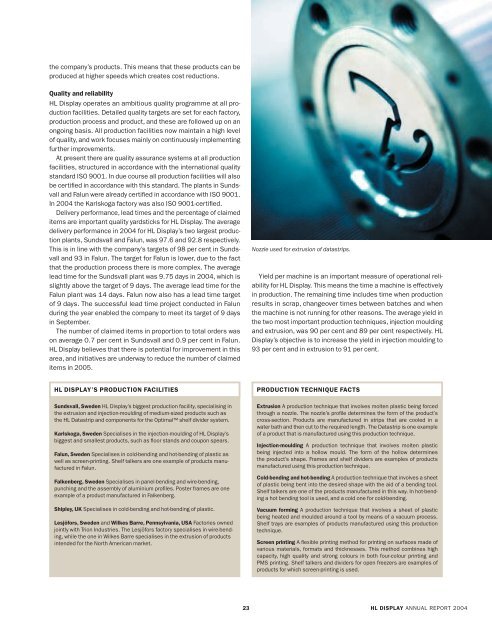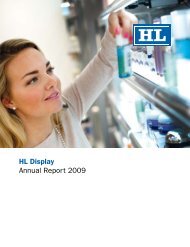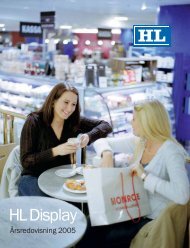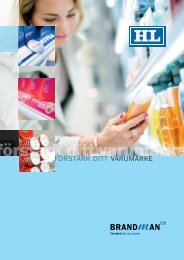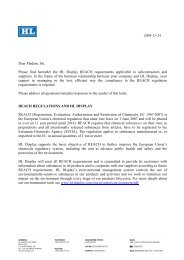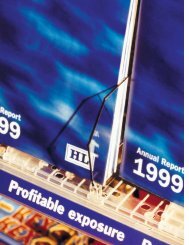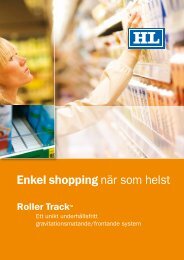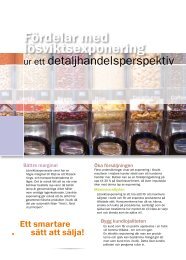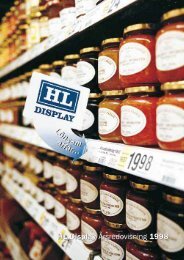Annual Report 2004 - HL Display
Annual Report 2004 - HL Display
Annual Report 2004 - HL Display
Create successful ePaper yourself
Turn your PDF publications into a flip-book with our unique Google optimized e-Paper software.
the company’s products. This means that these products can be<br />
produced at higher speeds which creates cost reductions.<br />
Quality and reliability<br />
<strong>HL</strong> <strong>Display</strong> operates an ambitious quality programme at all production<br />
facilities. Detailed quality targets are set for each factory,<br />
production process and product, and these are followed up on an<br />
ongoing basis. All production facilities now maintain a high level<br />
of quality, and work focuses mainly on continuously implementing<br />
further improvements.<br />
At present there are quality assurance systems at all production<br />
facilities, structured in accordance with the international quality<br />
standard ISO 9001. In due course all production facilities will also<br />
be certified in accordance with this standard. The plants in Sundsvall<br />
and Falun were already certified in accordance with ISO 9001.<br />
In <strong>2004</strong> the Karlskoga factory was also ISO 9001-certified.<br />
Delivery performance, lead times and the percentage of claimed<br />
items are important quality yardsticks for <strong>HL</strong> <strong>Display</strong>. The average<br />
delivery performance in <strong>2004</strong> for <strong>HL</strong> <strong>Display</strong>’s two largest production<br />
plants, Sundsvall and Falun, was 97.6 and 92.8 respectively.<br />
This is in line with the company’s targets of 98 per cent in Sundsvall<br />
and 93 in Falun. The target for Falun is lower, due to the fact<br />
that the production process there is more complex. The average<br />
lead time for the Sundsvall plant was 9.75 days in <strong>2004</strong>, which is<br />
slightly above the target of 9 days. The average lead time for the<br />
Falun plant was 14 days. Falun now also has a lead time target<br />
of 9 days. The successful lead time project conducted in Falun<br />
during the year enabled the company to meet its target of 9 days<br />
in September.<br />
The number of claimed items in proportion to total orders was<br />
on average 0.7 per cent in Sundsvall and 0.9 per cent in Falun.<br />
<strong>HL</strong> <strong>Display</strong> believes that there is potential for improvement in this<br />
area, and initiatives are underway to reduce the number of claimed<br />
items in 2005.<br />
<strong>HL</strong> DISPLAY’S PRODUCTION FACILITIES<br />
Sundsvall, Sweden <strong>HL</strong> <strong>Display</strong>’s biggest production facility, specialising in<br />
the extrusion and injection-moulding of medium-sized products such as<br />
the <strong>HL</strong> Datastrip and components for the Optimal shelf divider system.<br />
Karlskoga, Sweden Specialises in the injection-moulding of <strong>HL</strong> <strong>Display</strong>’s<br />
biggest and smallest products, such as floor stands and coupon spears.<br />
Falun, Sweden Specialises in cold-bending and hot-bending of plastic as<br />
well as screen-printing. Shelf talkers are one example of products manufactured<br />
in Falun.<br />
Falkenberg, Sweden Specialises in panel-bending and wire-bending,<br />
punching and the assembly of aluminium profiles. Poster frames are one<br />
example of a product manufactured in Falkenberg.<br />
Shipley, UK Specialises in cold-bending and hot-bending of plastic.<br />
Lesjöfors, Sweden and Wilkes Barre, Pennsylvania, USA Factories owned<br />
jointly with Trion Industries. The Lesjöfors factory specialises in wire-bending,<br />
while the one in Wilkes Barre specialises in the extrusion of products<br />
intended for the North American market.<br />
23<br />
Nozzle used for extrusion of datastrips.<br />
Yield per machine is an important measure of operational reliability<br />
for <strong>HL</strong> <strong>Display</strong>. This means the time a machine is effectively<br />
in production. The remaining time includes time when production<br />
results in scrap, changeover times between batches and when<br />
the machine is not running for other reasons. The average yield in<br />
the two most important production techniques, injection moulding<br />
and extrusion, was 90 per cent and 89 per cent respectively. <strong>HL</strong><br />
<strong>Display</strong>’s objective is to increase the yield in injection moulding to<br />
93 per cent and in extrusion to 91 per cent.<br />
PRODUCTION TECHNIQUE FACTS<br />
Extrusion A production technique that involves molten plastic being forced<br />
through a nozzle. The nozzle’s profile determines the form of the product’s<br />
cross-section. Products are manufactured in strips that are cooled in a<br />
water bath and then cut to the required length. The Datastrip is one example<br />
of a product that is manufactured using this production technique.<br />
Injection-moulding A production technique that involves molten plastic<br />
being injected into a hollow mould. The form of the hollow determines<br />
the product’s shape. Frames and shelf dividers are examples of products<br />
manufactured using this production technique.<br />
Cold-bending and hot-bending A production technique that involves a sheet<br />
of plastic being bent into the desired shape with the aid of a bending tool.<br />
Shelf talkers are one of the products manufactured in this way. In hot-bending<br />
a hot bending tool is used, and a cold one for cold-bending.<br />
Vacuum forming A production technique that involves a sheet of plastic<br />
being heated and moulded around a tool by means of a vacuum process.<br />
Shelf trays are examples of products manufactured using this production<br />
technique.<br />
Screen printing A flexible printing method for printing on surfaces made of<br />
various materials, formats and thicknesses. This method combines high<br />
capacity, high quality and strong colours in both four-colour printing and<br />
PMS printing. Shelf talkers and dividers for open freezers are examples of<br />
products for which screen-printing is used.<br />
PRODUKTION<br />
<strong>HL</strong> DISPLAY ANNUAL REPORT <strong>2004</strong>


